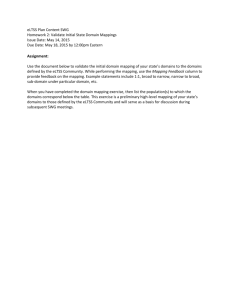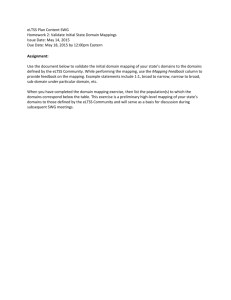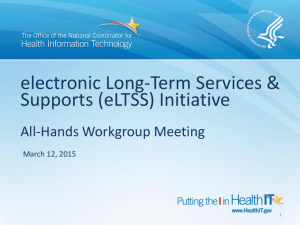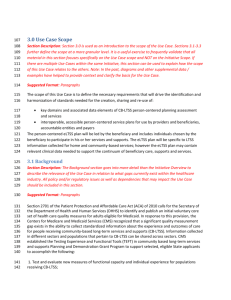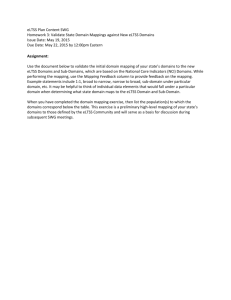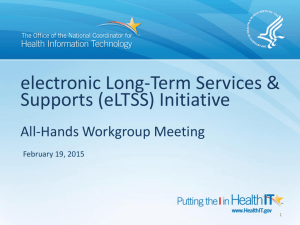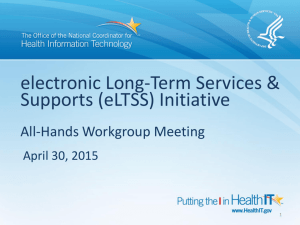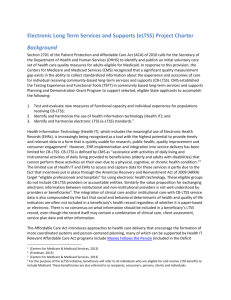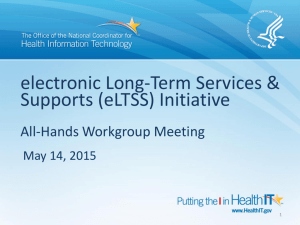Harmony Information Systems
advertisement
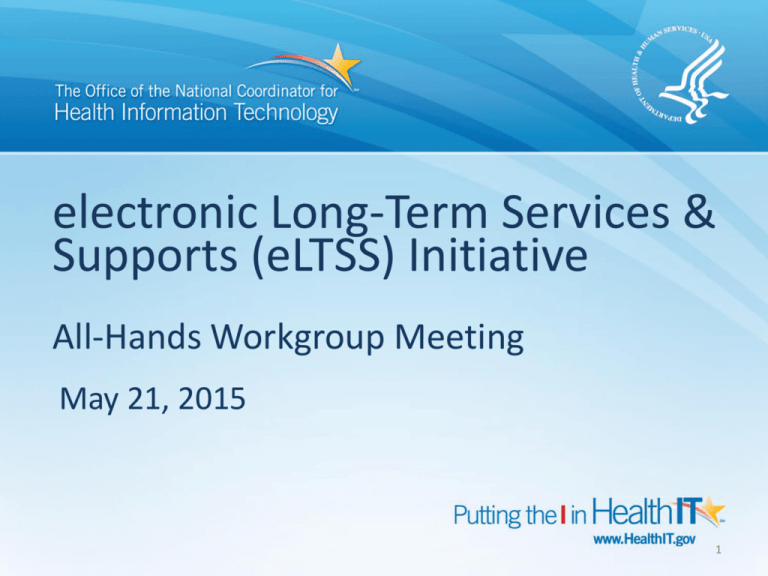
electronic Long-Term Services & Supports (eLTSS) Initiative All-Hands Workgroup Meeting May 21, 2015 1 Meeting Etiquette • • • • Remember: If you are not speaking, please keep your phone on mute Do not put your phone on hold. If you need to take a call, hang up and dial in again when finished with your other call o Hold = Elevator Music = frustrated speakers and participants This meeting is being recorded o Another reason to keep your phone on mute when not speaking Use the “Chat” feature for questions, comments and items you would like the moderator or other participants to know. o Send comments to All Panelists so they can be S&I Framework to Participants: addressed publically in the chat, or discussed in the From Hi everyone: remember to keep your phone on mute meeting (as appropriate). o Please DO NOT use the Q&A—only the presenter All Panelists sees Q&A, not necessarily the person facilitating the discussion 2 Agenda Topic Presenter Timeframe Welcome Announcements eLTSS Roadmap Lynette Elliott 10 mins eLTSS Plan Content SWG Debrief Grant Kovich 10 mins eLTSS Use Case End-to-End Review Becky Angeles 10 mins Concert Series Presentation: Harmony Information Systems John Byer 30 mins 3 Announcements Funding Opportunity: States encouraged to enhance access to long term services and supports through No Wrong Door Systems Eligible applicants must be from one of the 25 states which received a 2014 Transforming State LTSS Access Programs and Functions into A No Wrong Door System for All Populations and All Payers grant. Applicants must be a state entity and only one application can be submitted per state. The Office of the Governor must designate the state entity to be involved in the development and implementation of its NWD System. View Grant Opportunity: http://www.grants.gov/web/grants/view-opportunity.html?oppId=276621 http://acl.gov/Funding_Opportunities/Announcements/Index.aspx Conference Call for Potential Applicants: May 27, 2015, at 2:00 pm ET Call: 888-282-1672 Passcode: 3363664 Webinar Link: https://optum.webex.com/optum/j.php?MTID=m3ce54d749f5a3de764704b75de321bc3 Letter of Intent Due: June 14, 2015 Deadline for Application Submission: July 27, 2015, at 11:59 pm ET 4 Announcements HHS, CMS and ONC announced the release of the following on March 20, 2015: – Stage 3 Notice of Proposed Rulemaking (NPRM) for the Medicare and Medicaid Electronic Health Records (EHRs) Incentive Program • specifies new criteria that EPs, EHs, and CAHs must meet to qualify for Medicaid EHR incentive payments • proposes criteria that providers must meet to avoid Medicare payment adjustments based on program performance beginning in payment year 2018 – 2015 Edition Health IT Certification Criteria • aligns with the path toward interoperability identified in ONC's draft shared Nationwide Interoperability Roadmap • builds on past editions of adopted health IT certification criteria, • includes new/updated IT functionality and provisions that support the EHR Incentive Programs care improvement, cost reduction, and patient safety across the health system – Comment period ends May 29, 2015 5 Announcements (continued) • PUBLIC COMMENTS: You may submit comments, identified by RIN 0991-AB93, by any of the following methods (please do not submit duplicate comments). Because of staff and resource limitations, we cannot accept comments by facsimile (FAX) transmission. • • • Federal eRulemaking Portal: Follow the instructions for submitting comments. Attachments should be in Microsoft Word, Microsoft Excel, or Adobe PDF; however, we prefer Microsoft Word. http://www.regulations.gov . Regular, Express, or Overnight Mail: Department of Health and Human Services, Office of the National Coordinator for Health Information Technology, Attention: 2015 Edition Health IT Certification Criteria Proposed Rule, Hubert H. Humphrey Building, Suite 729D, 200 Independence Ave, S.W., Washington, D.C. 20201. Please submit one original and two copies. Hand Delivery or Courier: Office of the National Coordinator for Health Information Technology, Attention: 2015 Edition Health IT Certification Criteria Proposed Rule, Hubert H. Humphrey Building, Suite 729D, 200 Independence Ave, S.W., Washington, D.C. 20201. Please submit one original and two copies. (Because access to the interior of the Hubert H. Humphrey Building is not readily available to persons without federal government identification, commenters are encouraged to leave their comments in the mail drop slots 6 located in the main lobby of the building.) Announcements (continued) • 2015 Long Term Post Acute Care (LTPAC) & HIT Summit – What: The LTPAC HIT Summit is the premiere health IT conference for individuals within and working with the LTPAC industry for over 10 years. As the key conference of HIT leaders, policy makers, providers, vendors and professionals, the Summit continues to advance initiatives facing the long term, post acute care industry and priorities from the latest Roadmap for Health IT in LTPAC. – When: June 21-23, 8am-5pm ET – Where: Baltimore, MD in the Baltimore Hilton – To register: http://www.ahima.org/events/2015june-ltpac 7 Concert Series Presentations • Organizations are invited to present on an existing project or initiative that is related to the eLTSS scope of work and/or will help inform the eLTSS target outcomes and deliverables • These projects do not have to be technically-focused • Criteria for consideration: • Has solution, whether it is technical or process driven, been implemented in a one or more of the eLTSS settings: home and community-based setting or clinical setting? • Does solution incorporate existing or emerging standards and/or other relevant guidance? 8 Concert Series Presentations: Logistics • Presentations will be scheduled as part of the weekly eLTSS Community Meetings and will occur the last 30 mins of the call • Duration: 15-20 mins webinar (or demo); 5-10 mins Q&A • eLTSS Workgroup activities will always take precedence over concert series presentations • If you have an interest in participating, please contact Evelyn Gallego (evelyn.gallego@siframework.org ) and Lynette Elliott (lynette.elliott@esacinc.com) • A pre-planning meeting will be scheduled prior to any public demonstration 9 Upcoming Concert Series Presentations • • • • • May 28th: (available) June 4th: (available) June 11th: (available) June 18th: MyDirectives.com (A|D Vault) June 25th: Right Care Now 10 eLTSS Initiative Roadmap Q3 ‘14 Q4 ‘14 Q1 ‘15 Q2 ‘15 Q3 ‘15 Q4 ‘15 Q4 ‘17 Initiative Kick Off: 11/06/14 Pre-Planning • Call for Participation • Conduct Environmental Scan • Success Criteria • Stakeholder Engagement Phase 2: Use Case Development & Functional Requirements Phase 1: Pre-Discovery • Launch initiative • Review and Finalize Charter • Review initial Candidate Standards Phase 4: Pilots & Testing • Pilot site readiness • Implementation of • Develop, review, and finalize solution the Use Case and Functional • Test User Stories and Requirements Scenarios • Monitor Progress & Phase 3: Standards & Harmonization Outcomes Phase 5: Evaluation • Finalize Candidate Standards • Utilize Requirements Traceability Matrix • Standards Gap Analysis • Evaluate outcomes • Technical & Standards Design against Success • Develop Requirements Traceability Metrics and Matrix Criteria • Develop Implementation Guide • Update Implementation Guidance Timelines for Consideration: Two Pilot Phases, SDO Ballot Cycles 11 Goals for the eLTSS Initiative • Identify key assessment domains and associated data elements to include in an electronic Long-term Services & Supports (eLTSS) plan • Create a structured, longitudinal, person-centered eLTSS plan that can be exchanged electronically across and between community-based information systems, clinical care systems and personal health record systems. 12 eLTSS Use Case Development: Domain Identification 13 Domains eLTSS Plan: Proposed Domains & Sub-Domains Individual Outcomes Health, Wellness, and Rights System Performance Family Indicators Work Health Access Choice & Control Residence Sub-domains Community Inclusion Respect/ Rights Service Coordination Medications Choice & Decision Making Safety Relationships Satisfaction Self-Determination Satisfaction Financial/ Payer Information Family Involvement Wellness Community Connections Service Information Behavioral Needs Restraints Access & Support Delivery Staff Stability Information & Planning Cross-cutting Domains Person-Centered Profile Family Outcomes 14 eLTSS Plan Content SWG Information • Sign up for the eLTSS Plan Content SWG on the Wiki – http://wiki.siframework.org/eLTSS+Plan+Content+SWG – Joining the eLTSS Plan Content SWG ensures that you are included on workgroup communications and announcements. • Next eLTSS Plan Content SWG Meeting – Tuesdays (weekly) from 11:00am – 12:00pm Eastern – http://wiki.siframework.org/eLTSS+Plan+Content+SWG • Thank you! Your commitment and participation are critical to our success. 15 Project Charter and eLTSS Glossary • FINAL Published Project Charter located here: http://wiki.siframework.org/electronic+LongTerm+Services+and+Supports+%28eLTSS%29+Charter • eLTSS Glossary posted here: http://wiki.siframework.org/eLTSS+Glossary – The eLTSS Glossary is a working document containing eLTSS-relevant terms, abbreviations and definitions as defined by stakeholders – We are looking for your feedback and comments • Discussion Thread available • Submit any change requests via the Change Request Form located on the wiki – Reminder: the Glossary is a living document and content may change as the initiative progresses 16 Proposed Use Case Development Timeline Wk. Target Date (2015) 1-5 1/22-2/19 Use Case Kick-Off & UC Process Overview Use Case Value Framing Discussions Review and Answer Value Framing Questions on wiki 6 2/26 Review: Consolidated UC Value Framing Introduce: Context Diagram & User Stories Review: Context Diagram & User Stories 7 3/12 Finalize: Context Diagram & User Stories Review: User Stories 8 3/19 Review: User Stories Comments Review: User Stories, Glossary 9 3/26 Review: User Stories Introduce: Actors & Roles Review: User Stories, Actors & Roles 10 4/2 Finalize: Actors & Roles Introduce: In/Out of Scope Review: In/Out of Scope 11 4/9 Finalize: In/Out of Scope Introduce: Assumptions & Pre/Post Conditions Review: Assumptions & Pre/Post Conditions 12 4/16 Finalize: Scope, Assumptions & Pre/Post Conditions Introduce: Activity Diagram & Base Flow Review: Activity Diagram & Base Flow 13 4/23 Finalize: Activity Diagram & Base Flow Introduce: Functional Requirements & Sequence Diagram Review: Functional Requirements & Sequence Diagram 14 4/30 Finalize: Functional Requirements & Sequence Diagram Introduce: Data Requirements Review: Data Requirements 15 5/7 Finalize: User Stories Introduce: Risks, Issues & Obstacles Review: Risks, Issues & Obstacles 16 5/14 Dataset Requirements – eLTSS Plan Content SWG Review: Refer to SWG Homework 17 5/21 Begin End-to-End Review End-to-End Review by community (Ends 5/28 at 8pm ET) 18 5/28 End-to-End Comments Review & disposition 19 6/4 Finalize End-to-End Review Comments & Begin Consensus 20 6/11 Consensus Vote* All Hands WG Meeting Tasks Review & Comments from Community via Wiki page due following Tuesday by 8 P.M. Eastern Cast Consensus Vote 17 18 Use Case End-to-End Review & Consensus Timeline Date Item 5/21 Open End-to-End Review 5/28 Review End-to-End Comments (Close End-to-End Review at 8pm ET) 5/29-6/3 End-to-End Review Comment Dispositions 6/4 Open Consensus Voting 6/11 Close Consensus Voting at 8:00pm ET 6/12-17 Consolidate Votes and Address “No” Votes 6/18 Review Final Comment Dispositions and Complete all Outstanding Votes Verbally 6/19 Publish Consensus Voting Results 19 eLTSS Use Case End-to-End Review • The eLTSS Plan Use Case is ready for End-toEnd Review • This is your final chance to review and provide modifications prior to Consensus Voting • Please review the Use Case and provide comments: – Via the Wiki Comment Form – Via email to becky.angeles@esacinc.com • Comment Period Closes Thursday, May 28th at 8pm ET 20 Consensus on the Use Case • On June 4th, Committed members will be asked to cast a vote on the “eLTSS Plan Use Case” – Yes • A Yes vote does not necessarily mean that the deliverable is the ideal one from the perspective of the Initiative Member, but that it is better to move forward than to block the deliverable – Yes with comments • If a Consensus Process attracts significant comments (through Yes with comment votes), it is expected that the comments be addressed in a future revision of the deliverable. – Formal Objection- with comments indicating a path to address the objection in a way that meets the known concerns of other members of the Community of Interest. "Formal Objection" vote without such comments will be considered Abstain votes. • A Formal Objection means that the objector cannot proceed with the project unless the objections are met. It is acceptable and expected to use a Formal Objection in a first consensus round to communicate a point of view or process issue that has not been addressed in the drafting of the initial deliverable. • Should a Consensus Process attract even one "Formal Objection" vote with comments from an Initiative Member, the deliverable must be revised to address the "Formal Objection" vote (unless an exceptional process is declared). – Abstain (decline to vote) Note: Each Organization, no matter the number of Committed Members only receives 1 Vote. If there are multiple committed members from your organization please verify your collective vote with them 21 Submitting Your Vote http://wiki.siframework.org/electronic+Lo ngTerm+Services+and+Supports+%28eLTSS% 29+Consensus 1. Review the eLTSS Plan Use Case: – Final document will be available 6/3/2015 2. Complete the Voting Form: 1 – NOTE: You must be a Committed Member to Vote • • • • Yes Yes with comments. Formal Objection Abstain (decline to vote) 2 3. Submit your Vote 4. A message is displayed verifying your vote was recorded 3 4 22 Viewing Your Vote 5. You can view and track your Vote (located directly below the Voting Form) • Note: you may need to refresh your browser a few times to see your vote 5 Note: All Consensus Votes are due June 11th by 8:00 pm ET 23 Become a Committed Member • Only Committed Members are allowed to VOTE on the Use Case • If you are signed up as an Other Interested Party, you are not able to vote. However, you can change your status to Committed Member (so you can vote) here: – http://wiki.siframework.org/eLTSS+Join+the+Initia tive • Please contact Saurav Chowdhury (saurav.chowdhury@esacinc.com) if you would like to confirm your submission, change your status, or if you have any other membership/wiki concerns. 24 eLTSS All-Hands Next Steps • Complete an end-to-end review of the Use Case and provide comments/feedback by Thursday, May 28th at 8pm ET • Join us next Thursday, May 28th to review the end-to-end comments • We are looking for technical experts that have solutions for the next phase of our eLTSS work. Please spread the word to those you think could help us and have them join our Thursday All-Hands meetings. 25 26 eLTSS All-Hands Workgroup Concert Series Presentation May 21, 2015 John Byer, VP of Sales and Business Development jbyer@harmonyis.com Agenda • • • • • Who we are Medicaid-funded LTSS Perspectives Context for eLTSS Plan Key Concepts and Lessons Learned Trends 28 Purpose Built for LTSS Collaboration o Agencies, providers, MCOs, caregivers, families and beneficiaries work collaboratively around a single consumer view o Unified and interoperable data o Processes are real-time avoiding action taken based on outdated information o Process changes accommodated quickly o Engaged families and caregivers improve outcomes 29 Purpose Built Technology for HCB LTSS o Helps streamline access to LTSS o Facilitates creation of meaningful longitudinal data sets at participant and program levels o Shortens payment cycles for providers o Helps payers reduce risk, manage costs o Enables collaboration, Person-Centered Planning and Interoperability o “Future-Proof” 30 Technology for HCB LTSS o Modular, end-to-end automation o Intake o Level 1 Screen o Level 2 Assessment o Eligibility o Enrollment o Planning o Authorizations o Service Delivery o Billing o Oversight o Outcomes o Re-Assessment and ReEnrollment o Interoperable 31 Our Focus and Customers • Helping to Optimize Long Term Services and Supports (LTSS)/Home and Community Based Services (HCBS) since 1994 • Customers • State Level • Medicaid funded LTSS, including departments of Medicaid and other state agencies overseeing waivers (I/DD, People with Disabilities, Frail Elders, etc.), MCOs and other stakeholders • Other LTSS Programs, including OAA • Local • Regional LTSS Agencies, AAAs, Providers, CBOs and other partners • In 2015 will surpass 30,000 end users – all LTSS stakeholders 32 Agenda • • • • • Who we are Medicaid-funded LTSS Perspectives Context for eLTSS Plan Key Concepts and Lessons Learned Trends 33 Perspectives of State Agencies With Medicaid-funded LTSS Programs • Traditional • Visibility • Accountability • Quality • Waitlists • Provider Oversight/Incident Investigation • Outcomes • Efficacy • Financials • Reconciliation • Fraud • Security • Emerging • Managed LTSS • Person Centered Approaches • Interoperability • Quality Indicators and Analytics 34 Agenda • • • • • Who we are Medicaid-funded LTSS Perspectives Context for eLTSS Plan Key Concepts and Lessons Learned Trends 35 eLTSS Use Case (From eLTSS Initiative Use Case) 36 Streamlining LTSS: State View Beneficiary, Caregivers, other Team Members Participants Intake, Assessment and Eligibility Case assignment Interoperable Innovative Flexible eLTSS Plan Families Driven by needs of Individual MedicaidFunded Plans come with some strings Dashboards Authorizations Person Centered LTSS Incident & complaint mgmt. Delivery Billing, Payment Monitoring Enrollment Process for LTSS Financial Eligibility MMIS NWD Level 1 Screen Level 2 Level of Care Determination Choices Counseling MCI Enrollment MPI 38 Streamlining LTSS: State View Streamlining LTSS MPI Participants Assessment and Uniform Clinical/SNF Level of Care Determination Case assignment Interoperable Flexible eLTSS Plan Families Driven by needs of Individual Dashboards Authorizations Person Centered LTSS Incident & complaint mgmt. MMIS Delivery Billing, Payment Monitoring Agenda • • • • • Who we are Medicaid-funded LTSS Perspectives Context for eLTSS Plan Key Concepts and Lessons Learned Trends 40 Data Follows the Person Longitudinal Access, Inform, Assess & Enroll • • • • Call centers Web self-service Assessments Eligibility determination Care Coordination Measure & Analyze • • • • • • • • Person- Centered planning Team Engagement Service authorization, delivery and reimbursement Ongoing assessment and planning Confidential Information Outcomes Core quality measures Provider Oversight Financial and budget performance 41 Harmony Helping to Optimize HCBS Over 8 million participants receiving HCB LTSS 167 million service delivery records $12 Billion in HCB LTSS services 42 Helping to Identify Unmet Needs and Establish Clinical Eligibility Over 3.5 million consumers assessed Almost 10 million assessments sessions created Over 1 billion assessment questions answered All tracked longitudinally 43 Sample Assessment Interface Confidential Information 44 Cross-walking Longitudinal Assessment Data Confidential Information 45 Input from Consumer & Informal Supports Confidential Information 46 interRAI Clinical Assessment Protocols (CAPS) Confidential Information 47 Mobile Assessments Confidential Information 48 Mobile Assessments Confidential Information 49 Lessons Learned - Assessments Uniform Assessment Instruments Can be difficult politically Core Data Set Cross walking data important Managing change Maintaining longitudinal integrity can be hard Confidential Information 50 Consumer/Caregiver Module: Access Planned Services Confidential Information 51 Consumer/Caregiver Module: Access Support Plans Confidential Information 52 Lessons Learned – Consumer/Caregiver Portal Adoption is a work in progress Competing Needs Clear trend, gaining momentum Confidential Information 53 Rapid Change Healthcare Long Term Services and Supports Blending Healthcare and LTSS Integration – Interoperability – Security - Consent 54 Lessons Learned – Risk Time, Cost, Success/Failure Outside Factors Political/Institutional Resistance Custom Development Confidential Information 55 Lessons Learned - Stakeholders Many influencers within state enterprise Participants/Advocates State Agencies Legislatures, Governors CIOs Internal IT CMS Providers Some have the ability to enable adoption of interoperable eLTSS Plan and others have the ability to block it Must fit within state’s plan for security and access control Confidential Information 56 Agenda • • • • • Who we are Medicaid-funded LTSS Perspectives Context for eLTSS Plan Key Concepts and Lessons Learned Trends 57 Trends • • • Managed LTSS Person-centered approaches Interoperability • Influenced by states • Closed systems phased out • One-off custom IT projects? 58 Thank You John Byer – VP of Sales and Business Development jbyer@harmonyis.com eLTSS Initiative: Project Team Leads • ONC Leads – – • CMS Lead – • Grant Kovich (grant.kovich@accenture.com) Standards Development Support – • Becky Angeles (becky.angeles@esacinc.com) eLTSS Plan Content SWG Lead – • Lynette Elliott (lynette.elliott@esacinc.com) Use Case & Functional Requirements Development – • Evelyn Gallego-Haag (evelyn.gallego@siframework.org) Project Management & Pilots Lead – • Andrey Ostrovsky (andrey@careathand.com) Nancy Thaler (nthaler@nasddds.org) Terry O’Malley (tomalley@mgh.harvard.edu) Initiative Coordinator – • Jennie Harvell (jennie.harvell@hhs.gov) Community Leads – – – • Kerry Lida (Kerry.Lida@cms.hhs.gov) Federal Lead – • Elizabeth Palena-Hall (elizabeth.palenahall@hhs.gov) Patricia Greim (Patricia.Greim@hhs.gov) Angelique Cortez (angelique.j.cortez@accenture.com) Harmonization – Atanu Sen (atanu.sen@accenture.com) 60
